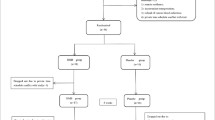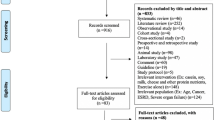Abstract
Background
Beta-hydroxy-beta-methylbutyrate (HMB) has been shown to be effective and superior to other types of protein supplements to attenuate loss of muscle mass, strength and function, however, its benefits in sarcopenic and frail older people remain unclear.
Objective
We seek to determine the effect of HMB on muscle mass, strength and function in older people with sarcopenia or frailty by reviewing results from available randomized controlled trials (RCTs).
Design
This review was registered at PROSPERO (University of York) with registration number CRD42018088462 and conducted according to the Preferred Reporting Items for Systematic Review and Meta-Analysis (PRISMA) guidelines. Using a pre-determined e-search strategy, we searched PubMed, Medline, EMBASE, CINAHL, LILACS, Web of Science, Cochrane and Scopus databases. Our inclusion criteria were RCTs that assessed the effect of HMB on muscle mass, strength and function in older people with sarcopenia and frailty aged ≥60 years. The main outcomes were lean body mass, handgrip, leg press strength, and Short Physical Performance Battery (SPPB) score.
Results
Three studies matched our eligibility criteria which enrolled 203 subjects through a variety of definitions of sarcopenia or frailty. Lean body mass increased and muscle strength and function were preserved following HMB supplementation.
Conclusion
HMB improves lean muscle mass and preserves muscle strength and function in older people with sarcopenia or frailty.

Similar content being viewed by others
References
He W, Goodkind D, Kowal P. An Aging World: 2015. U.S. Government Publishing Office, Washington, DC: U.S. Census Bureau; 2016.
Fujita S, Volpi E. Nutrition and Sarcopenia of Ageing. Nutrition Research Reviews. 2004;17(1):69–76.
Rolland Y, Czerwinski S, van Kan GA, Morley JE, Cesari M, Onder G, et al. Sarcopenia: Its Assessment, Etiology, Pathogenesis, Consequences and Future Perspectives. Journal of Nutrition Health and Aging. 2008;12(7):433–50.
Grimby G, Saltin B. The Ageing Muscle. Clinical Physiology. 1983;3(3):209–18.
Fried LP, Tangen CM, Walston J, Newman AB, Hirsch C, Gottdiener J, et al. Frailty in Older Adults: Evidence for a Phenotype. The Journals of Gerontology Series A, Biological Sciences and Medical Sciences. 2001;56(3):M146–56.
Xue QL. The Frailty Syndrome: Definition and Natural History. Clinics in Geriatric Medicine. 2011;27(1):1–15.
Topinkova E. Aging, Disability and Frailty. Annals of Nutrition and Metabolism. 2008;52 Suppl 1:6–11.
Wu H, Xia Y, Jiang J, Du H, Guo X, Liu X, et al. Effect of Beta–Hydroxy–Beta–Methylbutyrate Supplementation on Muscle Loss in Older Adults: a Systematic Review and Meta–Analysis. Archives of Gerontology and Geriatrics. 2015;61(2):168–75.
Wall BT, Gorissen SH, Pennings B, Koopman R, Groen BBL, Verdijk LB, et al. Aging Is Accompanied by a Blunted Muscle Protein Synthetic Response to Protein Ingestion. PLoS ONE. 2015;10(11):e0140903.
Welle S, Thornton C, Jozefowicz R, Statt M. Myofibrillar protein synthesis in young and old men. The American journal of physiology. 1993;264(5 Pt 1):E693–8.
Paw M, van Uffelen JGZ, Riphagen I, van Mechelen W. The Functional Effects of Physical Exercise Training in Frail Older People–A Systematic Review. Sports Medicine. 2008;38(9):781–93.
Yarasheski KE, Pak–Loduca J, Hasten DL, Obert KA, Brown MB, Sinacore DR. Resistance Exercise Training Increases Mixed Muscle Protein Synthesis Rate in Frail Women and Men =76 Year Old. American Journal of Physiology. 1999;277(1 Pt 1):E118–25.
Tieland M, van de Rest O, Dirks ML, van der Zwaluw N, Mensink M, van Loon LJC, et al. Protein Supplementation Improves Physical Performance in Frail Elderly People: A Randomized, Double–Blind, Placebo–Controlled Trial. Journal of the American Medical Directors Association. 2012;13(8):720–6.
Tieland M, Dirks ML, van der Zwaluw N, Verdijk LB, van de Rest O, de Groot L, et al. Protein Supplementation Increases Muscle Mass Gain During Prolonged Resistance–Type Exercise Training in Frail Elderly People: A Randomized, Double–Blind, Placebo–Controlled Trial. Journal of the American Medical Directors Association. 2012;13(8):713–9.
Deutz NE, Pereira SL, Hays NP, Oliver JS, Edens NK, Evans CM, et al. Effect of Beta–Hydroxy–Beta–Methylbutyrate (HMB) on Lean Body Mass during 10 Days of Bed Rest in Older Adults. Clinical Nutrition. 2013;32(5):704–12.
Landi F, Calvani R, Tosato M, Martone AM, Ortolani E, Savera G, et al. Protein Intake and Muscle Health in Old Age: From Biological Plausibility to Clinical Evidence. Nutrients. 2016;8(5):14.
Cruz–Jentoft AJ, Landi F, Schneider SM, Zúñiga C, Arai H, Boirie Y, et al. Prevalence of and Interventions for Sarcopenia in Ageing Adults: a Systematic Review. Report of the International Sarcopenia Initiative (EWGSOP and IWGS). Age and Ageing. 2014;43(6):748–59.
Wilson JM, Fitschen PJ, Campbell B, Wilson GJ, Zanchi N, Taylor L, et al. International Society of Sports Nutrition Position Stand: Beta–Hydroxy–Beta–Methylbutyrate (HMB). Journal of the International Society of Sports Nutrition. 2013;10:6–.
Baier S, Johannsen D, Abumrad N, Rathmacher JA, Nissen S, Flakoll P. Year–Long Changes in Protein Metabolism in Elderly Men and Women Supplemented With a Nutrition Cocktail of Beta–Hydroxy–Beta–Methylbutyrate (HMB), L–arginine, and L–lysine. Journal of Parenteral and Enteral Nutrition. 2009;33(1):71–82.
Calvani R, Miccheli A, Landi F, Bossola M, Cesari M, Leeuwenburgh C, et al. Current Nutritional Recommendations and Novel Dietary Strategies to Manage Sarcopenia. Journal of Frailty and Aging. 2013;2(1):38–53.
Van Koevering M, Nissen S. Oxidation of leucine and alpha–ketoisocaproate to beta–hydroxy–beta–methylbutyrate in vivo. The American Journal of Physiology. 1992;262(1 Pt 1):E27–31.
Wilson GJ, Wilson JM, Manninen AH. Effects of beta–hydroxy–beta–methylbutyrate (HMB) on exercise performance and body composition across varying levels of age, sex, and training experience: A review. Nutrition & Metabolism (Lond). 2008;5:1.
Baxter JH, Carlos JL, Thurmond J, Rehani RN, Bultman J, Frost D. Dietary Toxicity of Calcium Beta–Hydroxy–Beta–Methylbutyrate (CaHMB). Food and Chemical Toxicology. 2005;43(12):1731–41.
Durkalec–Michalski K, Jeszka J, Podgórski T. The Effect of a 12–Week Betahydroxy–beta–methylbutyrate (HMB) Supplementation on Highly–Trained Combat Sports Athletes: A Randomised, Double–Blind, Placebo–Controlled Crossover Study. Nutrients. 2017;9(7):1–21.
Chanet A, Verlaan S, Salles J, Giraudet C, Patrac V, Pidou V, et al. Supplementing Breakfast with a Vitamin D and Leucine–Enriched Whey Protein Medical Nutrition Drink Enhances Postprandial Muscle Protein Synthesis and Muscle Mass in Healthy Older Men. Journal of Nutrition. 2017;147(12):2262–71.
Hung W, Liu T, Chen C, Chang C. Effect of Beta–Hydroxy–Beta–Methylbutyrate Supplementation During Energy Restriction in Female Judo Athletes. Journal of Exercise Science and Fitness. 2010;8(1):50–3.
O’Connor DM, Crowe MJ. Effects of Beta–Hydroxy–Beta–Methylbutyrate and Creatine Monohydrate Supplementation on the Aerobic and Anaerobic Ccapacity of Highly Trained Athletes. Journal of Sports Medicine and Physical Fitness. 2003;43(1):64–8.
Silva VR, Belozo FL, Micheletti TO, Conrado M, Stout JR, Pimentel GD, et al. Beta–Hydroxy–Betaβ–Methylbutyrate Free Acid Supplementation May Improve Recovery and Muscle Adaptations After Resistance Training: a Systematic Review. Nutrition Research. 2017;45:1–9.
Higgins JPT, Green S. Cochrane handbook for systematic reviews of interventions version 5.1.0 [Updated March 2011]. The Cochrane Collaboration; 2011 [cited 15 May 2018]. [Available from http://handbook.cochrane.org].
Ryan R, Hill S. How to GRADE the quality of the evidence Version 1.0: Cochrane Consumers and Communication Group; 2016 [cited 3 June 2018]. [Available at http://cccrg.cochrane.org/author–resources].
Malafarina V, Uriz–Otano F, Malafarina C, Martinez J, Zulet M. Effectiveness of nutritional supplementation on sarcopenia and recovery in hip fracture patients. A multi–centre randomized trial. Maturitas. 2017; 101:[42–50 pp.].
Nissen S, Sharp R, Ray M, Rathmacher JA, Rice D, Fuller JC, Jr., et al. Effect of leucine metabolite beta–hydroxy–beta–methylbutyrate on muscle metabolism during resistance–exercise training. Journal of Applied Physiology (Bethesda, Md: 1985). 1996;81(5):2095–104.
Beaumier L, Castillo L, Yu YM, Ajami AM, Young VR. Arginine: new and exciting developments for an “old” amino acid. Biomedical and environmental sciences: BES. 1996;9(2–3):296–315.
El–Khoury AE, Pereira PC, Borgonha S, Basile–Filho A, Beaumier L, Wang SY, et al. Twenty–four–hour oral tracer studies with L–[1–13C]lysine at a low (15 mg.kg (–1).d (–1) and intermediate (29 mg.kg (–1).d(–1)) lysine intake in healthy adults. The American Journal of Clinical Nutrition. 2000;72(1):122–30.
Rand WM, Young VR. Statistical Analysis of Nitrogen Balance Data with Reference to the Lysine Requirement in Adults. The Journal of Nutrition. 1999;129(10):1920–6.
Gallagher PM, Carrithers JA, Godard MP, Schulze KE, Trappe SW. ß–hydroxy–ßmethylbutyrate ingestion, part II: effects on hematology, hepatic and renal function. Medicine & Science in Sports & Exercise. 2000;32(12):2116–9.
Sharawy MH, El–Awady MS, Megahed N, Gameil NM. The ergogenic supplement beta–hydroxy–beta–methylbutyrate (HMB) attenuates insulin resistance through suppressing GLUT–2 in rat liver. Canadian Journal of Physiology and Pharmacology. 2016;94(5):488–97.
Gerlinger–Romero F, Guimarães–Ferreira L, Giannocco G, Nunes MT. Chronic supplementation of beta–hydroxy–beta methylbutyrate (HMβ) increases the activity of the GH/IGF–I axis and induces hyperinsulinemia in rats. Growth Hormone &IGF Research. 2011;21(2):57–62.
Yonamine CY, Teixeira SS, Campello RS, Gerlinger–Romero F, Rodrigues CF, Jr., Guimaraes–Ferreira L, et al. Beta hydroxy beta methylbutyrate supplementation impairs peripheral insulin sensitivity in healthy sedentary Wistar rats. Acta Physiologica (Oxford, England). 2014;212(1):62–74.
Author information
Authors and Affiliations
Corresponding author
Electronic supplementary material
Rights and permissions
About this article
Cite this article
Oktaviana, J., Zanker, J., Vogrin, S. et al. The Effect of β-Hydroxy-β-Methylbutyrate (HMB) on Sarcopenia and Functional Frailty in Older Persons: A Systematic Review. J Nutr Health Aging 23, 145–150 (2019). https://doi.org/10.1007/s12603-018-1153-y
Received:
Accepted:
Published:
Issue Date:
DOI: https://doi.org/10.1007/s12603-018-1153-y




